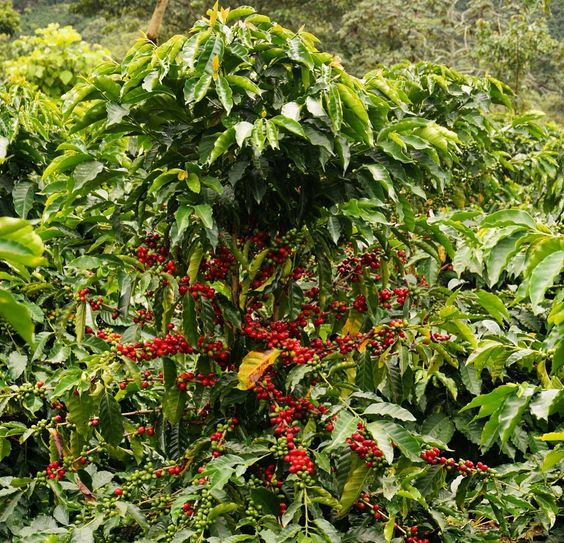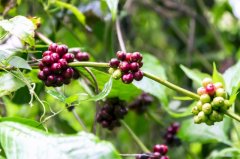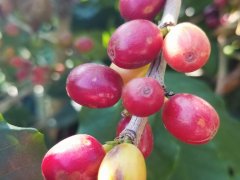Yunnan Coffee Tour | which Yunnan Coffee Brand is good? how to grow Yunnan small Coffee

Professional coffee knowledge exchange more coffee bean information please follow the coffee workshop (Wechat official account cafe_style)
How to brew Yunnan small grains of coffee
In fact, this is the nth time to Yunnan. From the beginning of baking beans, I gradually have doubts about the variety of coffee. In addition to altitude, soil, climate and other factors, I personally think that variety is the key to determine the flavor of beans. This time, I started to be a coffee thief along the road all the way south. From 800m at the foot of the mountain to 1500 m above sea level, we pick fresh coffee and fruit all the way.
Along the way, most of the varieties planted in Yunnan are Katim, which is a hybrid of Kaddura and Robusta, a branch of the bourbon line in the Arabica species. The reason for planting this variety is that Katim has the Robusta gene, so it is better than a single old variety in disease resistance, and the yield is good. Compared with the delicate old variety, the disease resistance is poor and the yield is low. Farmers naturally prefer to plant Katim. So now there has been a Katim wind in Yunnan.
(leaf rust, one of the natural enemies of coffee trees)
(Tibica tree)
The new leaves at the tips of the branches and leaves above are copper, which is Tiebika growing coffee trees. Tiebika is an old variety of Arabica species, and the well-known Hawaiian Kona is actually Tibika. In the vast expanse of Katim, it is easy to recognize. After careful observation, you will find that each species has its own appearance, Katim's leaves are hanging down, the tree shape seems to be wearing a cloak. Tiebika, on the other hand, has upward branches and new leaves on the top of the tree.
Finally, we picked fresh fruits of Tibika coffee at three elevations, 800m, 1200 m and 1500 m.
I want to try the effect of the sun.
The follow-up work is the hardest. Peel off the fruit, soak and rinse, dry and peel the fruit.
On this trip to Yunnan, I not only want to know about the varieties, but also want to take a closer look at the land in Yunnan. Can we grow high-quality high-quality coffee like other coffee-producing countries? In fact, the hardware conditions are completely possible, the altitude is enough, the soil is no problem, and the climate is also fine. Perhaps the only trouble is the cultivation of varieties. What kind of varieties is suitable for this soil, and what kind of varieties can shine here?
Refer to the cultivation of small grain coffee in Yunnan:
Coffee tree
Families and genera: evergreen trees of the coffee subgenus Rubiaceae
Morphological characteristics
Coffee is a perennial evergreen shrub or small tree of Rubiaceae. It is a horticultural perennial cash crop with the characteristics of fast growth, high yield, high value and wide market. Wild coffee trees can grow to 5 to 10 Michael, but coffee trees planted on the manor are often cut to a height of less than 2 meters in order to increase fruit and facilitate harvesting. Coffee tree opposite leaves are long oval, smooth leaves, the end of the branch is very long, few branches, and the flowers are white, open at the base of the petiole connecting the branch. The ripe coffee berries look like cherries and are bright red with sweet flesh and contain a pair of seeds, namely coffee beans (Coffee Beans).
Growth habit
Coffee beans like warmth, drought and cold tolerance, afraid of freezing, seedlings and adult plants are vulnerable to frost defoliation to death, seeds can not mature. Coffee beans are not strict on land, and idle land can also be planted, but it is suitable for sandy soil with good drainage, deep soil layer and loose and fertile soil.
Seed propagation
In the full ripening stage of coffee (the full ripening period of medium-grain coffee in Hainan Island is 2ml-March, small-grain coffee 9Mel-November), fully ripe fruits are picked from strong and high-yielding mother trees to make seeds. After the fruit is harvested, immediately peel and wash the seeds, the method is to put the fruit on the hard and rough ground, grind the peel with a brick, or peel it off with a peeling machine, then put it in water to remove the peel, take out the seed, stir it with furnace ash, and rinse it in water to wash the gum on the surface of the seed. In the process of seed washing, be careful not to break the seed shell so as not to affect germination. The germination rate of seeds without seed shell is only 54%. If the seed shell is preserved, the germination rate can reach more than 80%. After the seeds are washed, they should be dried in a ventilated place and should not be exposed to the sun. When the seeds are exposed to 15% water content, the germination rate will be significantly reduced. Dry seeds should not be hidden for a long time. Medium-grain coffee will lose its germinating power when it is stored for more than three months. For small seed coffee, the seed harvest time is from September to November. After the seed is collected, it is a low-temperature winter. The seeds can be stored for sowing in February-March of the following year, but they should be placed in a ventilated, cool and dry place and checked frequently to prevent mildew.
The ideal planting conditions for coffee trees are as follows: the temperature is between 15 ℃ and 25 mm, and the annual rainfall must reach 1500 mm, and the rainfall time should be in line with the flowering cycle of coffee trees. Of course, in addition to the seasonal rainfall, there should also be fertile soil and good drainage. Fertile soil containing volcanic ash, in addition, although sunlight is an indispensable element for the growth and fruit of coffee, too strong sunlight will inhibit the growth of coffee trees, so various producing areas usually cooperate with the planting of some shade trees. As for the ideal altitude, the altitude is 500 Muhami 2000 meters.
There is a folk method of pickling sprouts. After soaking in about 50 ℃ of warm water for one day and night, pour out the water, rinse it again with clean water, and then cover it with a wet cloth to maintain humidity. After three days, it can sprout and select those with a bud rate of more than 85% as seeds. You might as well try-- .
.
Important Notice :
前街咖啡 FrontStreet Coffee has moved to new addredd:
FrontStreet Coffee Address: 315,Donghua East Road,GuangZhou
Tel:020 38364473
- Prev

Why is the price of a can of Yunnan small grain coffee so low? Is Yunnan small grain coffee a boutique coffee?
Professional coffee knowledge exchange more coffee bean information please follow the coffee workshop (Wechat official account cafe_style) how to brew Yunnan small coffee in 1955, Yunnan reclamation people began to introduce and try to grow coffee, this is the starting point of Yunnan coffee after the founding of the people's Republic of China. Therefore, with the rise and growth of Yunka, Yunnan has an overall plan for land reclamation. Chi Zhonghua said: in terms of regional layout, we hope to break
- Next

Yunnan Baoshan Coffee Bean Brand Yunnan Coffee Why is there a good Yunnan small Coffee?
Professional coffee knowledge exchange more coffee bean information please follow the coffee workshop (Wechat official account cafe_style) Yunnan small coffee how to brew as a coffee control, favorite is delicious all kinds of coffee. When I came to Baoshan, Yunnan Province this time, I unexpectedly tasted one of the best coffee I have tasted in recent years. In fact, I made my first trip to Yunnan more than ten years ago, in Lijiang.
Related
- Detailed explanation of Jadeite planting Land in Panamanian Jadeite Manor introduction to the grading system of Jadeite competitive bidding, Red bid, Green bid and Rose Summer
- Story of Coffee planting in Brenka region of Costa Rica Stonehenge Manor anaerobic heavy honey treatment of flavor mouth
- What's on the barrel of Blue Mountain Coffee beans?
- Can American coffee also pull flowers? How to use hot American style to pull out a good-looking pattern?
- Can you make a cold extract with coffee beans? What is the right proportion for cold-extracted coffee formula?
- Indonesian PWN Gold Mandrine Coffee Origin Features Flavor How to Chong? Mandolin coffee is American.
- A brief introduction to the flavor characteristics of Brazilian yellow bourbon coffee beans
- What is the effect of different water quality on the flavor of cold-extracted coffee? What kind of water is best for brewing coffee?
- Why do you think of Rose Summer whenever you mention Panamanian coffee?
- Introduction to the characteristics of authentic blue mountain coffee bean producing areas? What is the CIB Coffee Authority in Jamaica?

